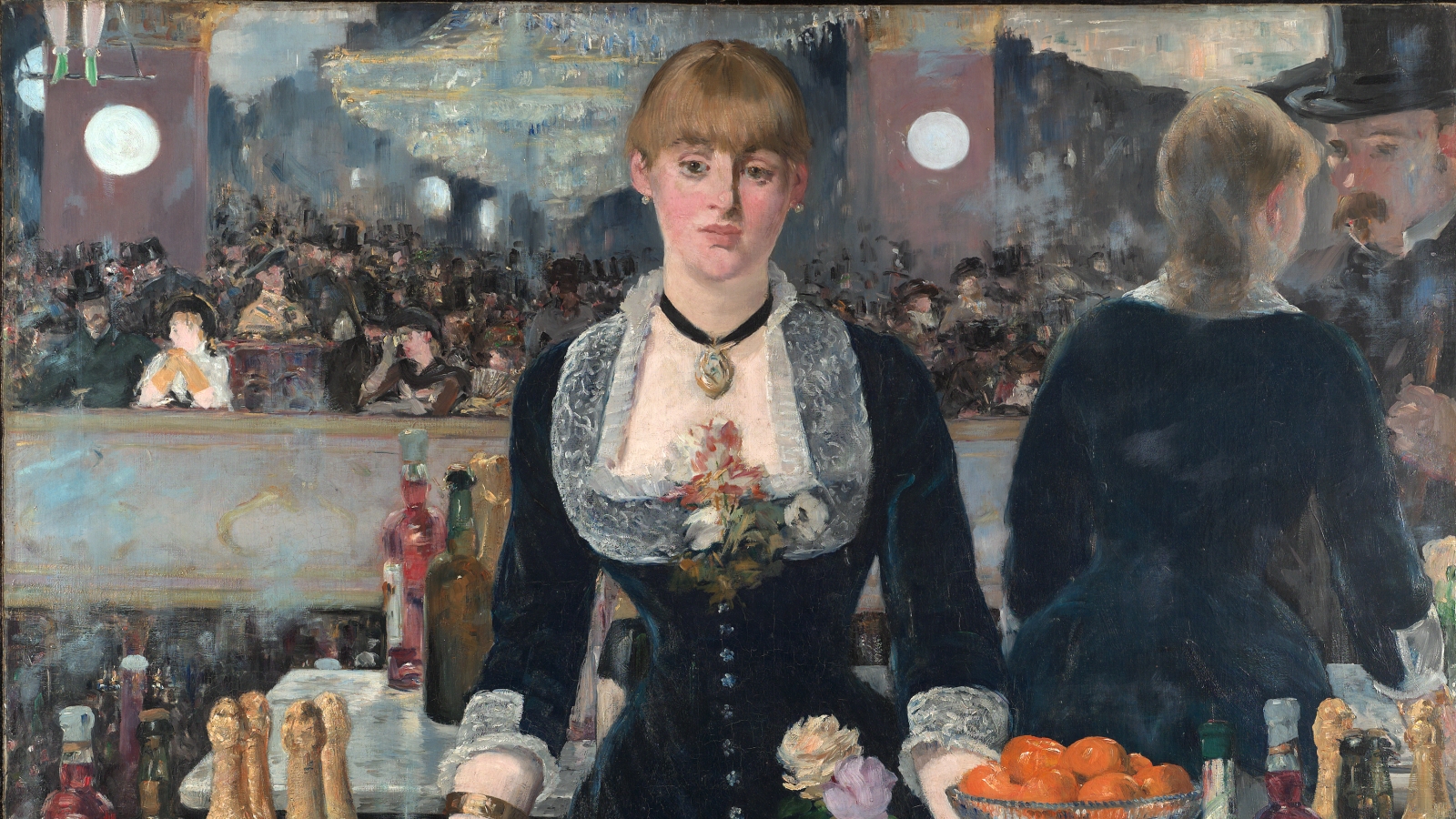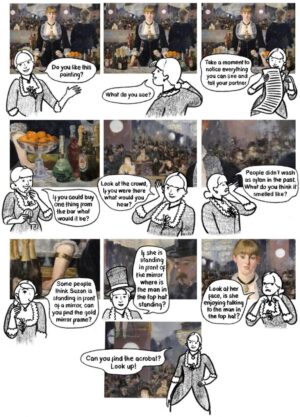
Make a Story Picture inspired by Edouard Manet
This activity encourages you to explore the work of Edouard Manet (1832 – 1883), namely A Bar at the Folies-Bergère.
Manet was a painter working in Paris at the end of the 19thcentury who enjoyed painting modern life around him. The place in the painting was called the Folies-Bergere. It was a theatre and bar where people would go to watch performances, socialise and buy drinks from Suzon, the barmaid in the picture. It might look old fashioned now but when it was painted over one hundred years ago it showed some of the latest technologies; it’s one of the earliest paintings to show us electric lights!
This painting is full of symbols that help us understand where we are. A symbol is like a clue that lets you know something about the painting; we could say the bottles at the front are a symbol that people are drinking or that the chandeliers in the background let us know this is a fancy place!
Manet showed this painting at a large and important exhibition in Paris called the Salon. At the Salon many people didn’t like the picture; they said a modern barmaid in a bar was not an appropriate subject for a painting. Do you think there are any stories that are not appropriate for paintings? In the hundred years since this was painted people have become more interested in the story of this place and the barmaid who worked there. Would you like to find the symbols and piece together her story?
Materials
- A sheet of Paper
- Pencil
- Colouring Pencils (optional)
- A Mirror
- Some of your favourite foods and drinks, your favourite cup to drink from
- Your favourite outfit or top to wear
- Something important to you (e.g a toy, a decoration or a souvenir)


A Closer Look
With a partner use the questions below to take a deeper look at the painting and have a discussion about it. These questions are to help you look more closely at the painting, there are no right or wrong answers.
- Do you like this painting?
- What do you see? (take a moment to notice everything you can see and tell your partner)
- If you could buy one thing from the bar what would it be?
- Look at the crowd – if you were there what would you hear?
- What do you think it smells like?
- Some people think Suzan is standing in front of a mirror – can you see a gold mirror frame?
- If she is standing in front of a mirror, where is the man in the top hat standing?
- Look at her face – is she enjoying talking to the man in the top hat?
- Can you spot the acrobat in the painting?

Activity One: A New Perspective
We’re going to imagine we’re at the Folies-Bergere. We can hear the crowd and smell the smells and see the whole story from a new point of view.
Take a close look at the painting and pick someone in the picture you would like to be. You could be Suzon or the woman with binoculars or the acrobat or even an orange in a crystal bowl!
Think about what that person can see, imagine how they feel.
Try to draw the scene from this person’s perspective.
Include as many details from the picture as you can to tell the story.
When you have finished show your partner your drawing – can they guess who you were pretending to be?
Activity Two: A Picture Full of Clues
Manet wanted to tell us about the world he was living in by using objects, places and facial expressions as symbols or clues. You are going to make a picture that tells a story about you, full of symbols and clues about where you are and what you like.
To Make Your Picture
Sit in front of your mirror wearing your favourite outfit with your favourite food, drink and cup near you. Hide your important object somewhere in the room so you can see it in the mirror – like the acrobat’s legs at the top of the painting!
- Take a moment to notice everything you can see
- Look at the food and drink in the mirror. How does it make you feel?
- Look at your face in the mirror. Does it show how you’re feeling?
- Look at the way you are sitting. Do you look happy, or excited or something else?
- Look at your hidden object, will people spot it? What will they think when they see it?
- Look at the room around you in the mirror. What can you see?
- Are there any other symbols or clues in the room that would tell people about you?
- Do you want to include these symbols or do you want to keep them secret?
- Make a drawing of what you can see in the mirror; you can even draw the frame around the edge to let people know it’s a mirror.
- Add colours with coloured pencils if you have them.
- Don’t worry about it being neat or perfect: when Manet made his picture people told him it was far too messy and now it’s one of the most popular paintings in the gallery!
- Once you have finished show your picture to someone in your house. Ask them what clues they can find about you from your picture.
- Can you make another picture full of symbols you don’t like? How would it be different?

We’d love to see your Manet inspired works of art. Please share your artworks with us (and let us know your name and age)
Twitter: @TheCourtauld
Facebook : The Courtauld
Instagram: @Courtauld





